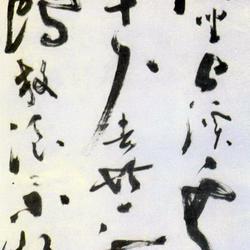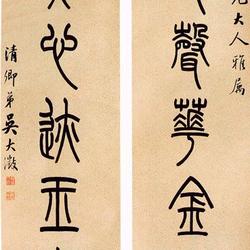
"Zi Shu Qi Jue Poetry Scroll" scroll, damask, running script, 256cm in length and 48.4cm in width. Collection of the Palace Museum, Beijing This volume was written in the second year of Ming Dynasty (1622), when Dong Qichang was 68 years old. According to the records in Volume 288 of "History of the Ming Dynasty", in order to compile the "Records of Shenzong", Dong Qichang, who had just been promoted to Taichang Temple minister and concurrent bachelor, was sent to Jiangnan to collect and compile the chapters and remains of the previous dynasties. He took this opportunity to visit the books on an imperial mission, and together with Mi Wanzhong and other friends, he visited the collection of famous French calligraphy and paintings in the south of the Yangtze River. This ink mark is the result of the author and Mi "writing a chronicle of these old works" after they visited the Jinling Mausoleum to view the famous paintings and calligraphy collected by the collector Tang Jun Yu Fuzhong III. The postscript of King Shu of the Qing Dynasty called it "this is the most thoughtful work of literary sensitivity". The paragraph in Volume 28 of "Shiqu Baoji", "A Volume of Manuscripts of Dong Qichang's Poems of the Ming Dynasty" says: "The poems after You are all written in Minangong regular script." The calligraphy on this scroll not only has the meaning of Mi Fu's calligraphy, but also has its own style. The writing style is changeable, clumsy and skillful, simple and natural, and the style is elegant. It is one of Dong's fine calligraphy works. (Writer: Wen Jinxiang) Explanation: Shishi Kuizhang is waiting for an interview. The Jun family has its own old green felt. If the master hides many angry monsters, why should Changxian lose his salary? On the ninth day of the second month of Renxu in the second year of Tianqi, I visited your nephew Yu Nian. At that time, Miyou Shi Canzhi returned to Jinhua with the congratulations of longevity, and the six Jin Mausoleums gathered in Jun Yuzhai. I will spend the rest of the day looking at the Dharma books and paintings collected by the third generation of the Jun family, and write down the chronicles of these old works. Dong Qichang. Seal seals of "Tai Shi clan", "Dong clan Xuanzai" and "Xuan Shang Zhai". On the lower left side of the painting is a postscript written by Shushu, the king of the Qing Dynasty.

















